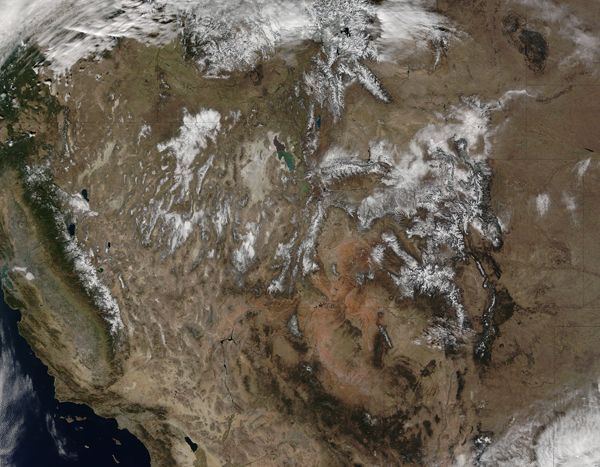Images
November 20, 2015 - Snow in the mountains of western United States
Tweet
Parts of Canada and the western United States were doused with wintery weather in mid-November 2015. Some of the precipitation fell as snow and some as cold rain. Whether it is the beginning of a wet El Niño winter or a break in persistent drought remains to be seen.
The Moderate Resolution Imaging Spectroradiometer (MODIS) on NASA’s Terra satellite captured this true-color image on November 14 after storms dropped snow across the western United States from California to Colorado.
In the Pacific Northwest, between November 12 and 16, a stream of moisture from the Pacific Ocean, known as an atmospheric river, pummeled Washington. The lower elevations of the Olympic mountains received 250 mm (10 in) of rain, according to the Seattle Times. Precipitation fell as snow at higher elevations.
Previous research has shown that El Niño appears to influence atmospheric river events in California. During El Niño winters, atmospheric rivers tend to carry more water vapor to California, leading to more intense precipitation. But the streams of airborne moisture also tend to be warmer during El Niño.
How the current El Niño affects drought in California and other western states is an open question. Strong El Niños often influence on winter weather across the country, but other factors can play a role, including the Arctic Oscillation and the Madden-Julian Oscillation. According to the U.S. winter outlook issued by NOAA’s Climate Prediction Center (CPC), a wetter-than-average winter is expected across the lower half of the United States, from central and southern California across Texas to Florida and some of the East Coast. The CPC outlook notes that “some improvement is likely in central and southern California by the end of January, but not drought removal.”
Image Facts
Satellite:
Terra
Date Acquired: 10/14/2015
Resolutions:
1km (859.6 KB), 500m (3.1 MB), 250m (7.5 MB)
Bands Used: 1,4,3
Image Credit:
Jeff Schmaltz, MODIS Land Rapid Response Team, NASA GSFC
Tweet
Parts of Canada and the western United States were doused with wintery weather in mid-November 2015. Some of the precipitation fell as snow and some as cold rain. Whether it is the beginning of a wet El Niño winter or a break in persistent drought remains to be seen.
The Moderate Resolution Imaging Spectroradiometer (MODIS) on NASA’s Terra satellite captured this true-color image on November 14 after storms dropped snow across the western United States from California to Colorado. In the Pacific Northwest, between November 12 and 16, a stream of moisture from the Pacific Ocean, known as an atmospheric river, pummeled Washington. The lower elevations of the Olympic mountains received 250 mm (10 in) of rain, according to the Seattle Times. Precipitation fell as snow at higher elevations.
Previous research has shown that El Niño appears to influence atmospheric river events in California. During El Niño winters, atmospheric rivers tend to carry more water vapor to California, leading to more intense precipitation. But the streams of airborne moisture also tend to be warmer during El Niño.
How the current El Niño affects drought in California and other western states is an open question. Strong El Niños often influence on winter weather across the country, but other factors can play a role, including the Arctic Oscillation and the Madden-Julian Oscillation. According to the U.S. winter outlook issued by NOAA’s Climate Prediction Center (CPC), a wetter-than-average winter is expected across the lower half of the United States, from central and southern California across Texas to Florida and some of the East Coast. The CPC outlook notes that “some improvement is likely in central and southern California by the end of January, but not drought removal.”
Image Facts
Satellite:
Terra
Date Acquired: 10/14/2015
Resolutions:
1km (859.6 KB), 500m (3.1 MB), 250m (7.5 MB)
Bands Used: 1,4,3
Image Credit:
Jeff Schmaltz, MODIS Land Rapid Response Team, NASA GSFC




